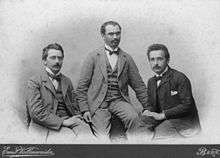Maurice Solovine

Maurice Solovine (1875–1958) was a Romanian philosopher and mathematician.
As a young student of philosophy in Bern Solovine applied to study physics with Albert Einstein in response to an advert. The two men struck up a close relationship and Einstein was to say to Solovine a few days after meeting him: "It is not necessary to give you lessons in physics, the discussion about the problems which we face in physics today is much more interesting; simply come to me when you wish, I am pleased to be able to talk to you."
Solovine one day suggested reading and debating the works of great authors. Einstein agreed enthusiastically and soon mathematician Conrad Habicht (1876–1958) became involved in what was to be known as the "Akademie Olympia" (Olympia Academy). Often their meetings, held in Einstein's flat, would last until the early morning hours.
On one occasion Solovine missed a scheduled meeting in his flat, preferring to listen to a concert in the city. He had prepared a meal for his friends with a note: "Amicis carissimis ova dura et salutem." (To the beloved friends, hard-boiled eggs and greetings). However Einstein and Habicht turned his flat upside down after they had eaten the meal. Every piece of furniture was moved and plates, cups, forks, knives and books were scattered all over the flat. The rooms were also covered in smoke from Einstein’s pipe and Habicht’s cigar. They left a "worthy warning" on the wall. There you could read: "Amico carissimo fumum spissum et salutem." (To the dearest friend, thick smoke and greetings). Einstein is reputed to have greeted Solovine the next evening with the following words: "You lousy guy, how, you were cheeky enough to stay away from a meeting of the Akademie to listen to the violin? Barbarian, idiot, stupid one, if you ever let us down this way again you’ll be expelled from the Akademie with shame." This meeting lasted until the morning to make up for lost time.
Solovine remained in contact with Einstein into the fifties.
References
- Maurice Solovine (ed.) Albert Einstein - Lettres à Maurice Solovine, Paris: Gauthier-Villars, 1956.
- Akademie Olympia
|